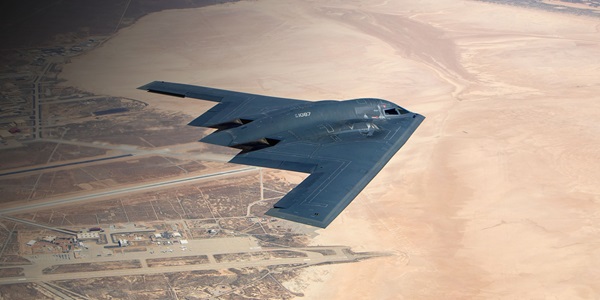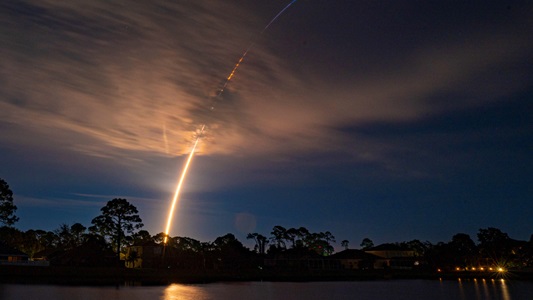A Legacy of Pioneering Tech to Protect the Warfighter
Need for Speed
Propelling American Hypersonics to Possible

By Jordan Orris
America’s potential adversaries are getting faster.
They are making advances in hypersonic capabilities and may already be fielding hypersonic missiles. It’s a pivotal time for national security, and Northrop Grumman has risen to the occasion as a key player in the race for speed, manufacturing America’s first hypersonic weapons.
The aerodynamics textbook definition of “hypersonic” is travel at Mach 5 or greater — more than five times the speed of sound, almost a mile each second. Long-range hypersonic vehicles often utilize a scramjet engine, which leverages the vehicle’s high speed to compress incoming air through a special inlet into a combustion chamber. There, oxygen in the air combines with fuel and is ignited, creating tremendous thrust that enables sustained hypersonic flight propelling it further and faster.
“Hypersonic technologies provide our warfighters more capability than ever before. With Mach 5 speeds, targets in contested areas can be addressed in less than 20% of the time that it takes a current system. Hypersonic missiles’ speed and maneuverability make them difficult to intercept, meaning they are not only effective weapons, but an even stronger deterrent to aggression,” said Ricardo Puig, a Northrop Grumman hypersonics program manager. Hypersonic speed allows the warfighter to fight from further away (more safely), with highly capable weapons that will reach the target faster than ever before, while also avoiding adversary countermeasures.
Making Hypersonics Possible
Northrop Grumman has been working on hypersonic technologies since the 1960s, with early demonstrated hypersonic wind tunnel tests at our applied science laboratory in Ronkonkoma, New York. It’s been decades of experience perfecting proprietary propellant mix recipes; decades of experience in engineering, manufacturing and assembling tactical rocket motors for the United States and its allies; and decades of knowledge from the top hypersonics experts in the world, ideating together to deliver the nation’s first hypersonic propulsion production capability. We have sites in four states, all working together to make hypersonics possible.
Mackenzie Martin-Jones is a propulsion engineer tasked with leading the design team of the inlet for scramjet engines.
“Contributing to a product line that is breaking sound and technological barriers has been an amazing opportunity. It is an honor to have a hand in a technology with a rich legacy and high importance to national security that is defining possible in aerospace. We are engineering the future, today,” shared Mackenzie.
Hypersonic Production: Loading
Northrop Grumman opened the first U.S. facility designed specifically for manufacturing of air-breathing propulsion, including hypersonic scramjet propulsion. Our Hypersonics Capability Center (HCC) in Elkton, MD is an advanced manufacturing facility with infrastructure and capacity necessary to cost-effectively produce hypersonic propulsion at scale, supporting the U.S. Department of Defense’s (DoD) growing demands for long range, rapid response weapons.
Our scramjet has soared through initial ground and flight testing, and we are now applying the key demonstrated technologies toward multiple weapons development efforts. We are able to leverage revolutionary advancements in combustor technologies, thermal management, materials, manufacturing capabilities and our supply chain to provide compact, affordable range extension to customers in the DoD and American allies.
The science of hypersonics is applicable to multiple platforms, including powering drones and manned aircraft. Once perfected, hypersonics will enable commercial airplanes to cross oceans faster than ever before and may even revolutionize commercial space flight.
“Working with hypersonics has always been my dream, since the potential of this cutting-edge aerospace technology is simply staggering, even outside defense. Think of being able to one day fly from Houston to Paris in two hours,” said Ricardo.
The hypersonics race is underway, and here at Northrop Grumman we are propelling the United States and our allies to success.
Learn more about our work in Hypersonics, our unique Hypersonics Capabilities Center and our commitment to delivering advanced propulsion and high-speed systems. If you’re interested in defining possible with us, explore what life’s like at Northrop Grumman.
Solving the Toughest Problems
Whether you want to design next-generation aircraft, harness digital technologies or build spacecraft that will return humanity to the moon, working at Northrop Grumman means you’ll contribute to technology that’s transforming the world. Check out our career opportunities to see how you can help define possible.


